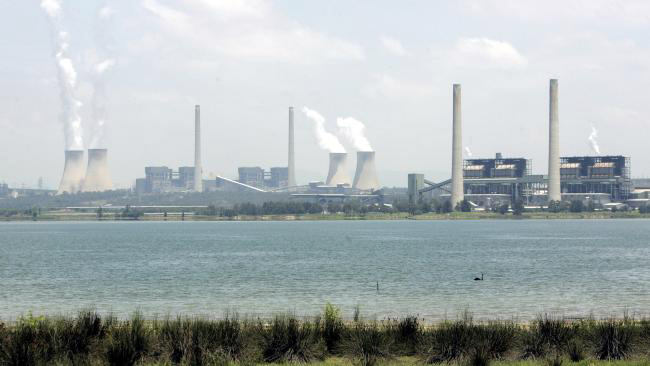The PM’s take on Australia’s energy management just doesn’t stack up.

Liddell (right) and Bayswater power stations, near Muswellbrook in the Hunter Valley. PHOTO The Australian
We all carry with us a narrative that gives shape to our lives. From time to time we might adjust our story to meet changing circumstances, but no-one does it like Malcolm Turnbull
The narrative he took on in opposition was about being a champion of strong climate action. When he toppled Tony Abbott as prime minister in 2015 he dropped that in favour of innovation. Two years on, he now has another story. It goes something like this:
“All the problems we face in the energy market today are the fault of my political opponents. In their zeal to convert us to renewables they forgot about keeping lights on and power prices down.
“Blackout Bill and various incompetent colleagues in South Australia and Victoria are entirely to blame. Their ambitious targets for windmills and solar panels caused coal power stations to shut down, while they locked up gas supply in foreign contracts and blocked new gas exploration.
“Coal used to be a problem because of climate change, but my government’s climate target has all that sorted. Coal is now fine, as are the old power stations that rely on it, which must be kept running at whatever cost. Emissions are of no consequence.
“My government’s innovation credentials were on show in March and April this year when I announced plans in the Snowy Mountains and then in Tasmania to pump water uphill so it can make more renewable electricity.”
A little incoherent, but that’s as near as I can get to Malcolm Turnbull’s story today.
The story has a small cheer squad within the Coalition, but most Australians seem to think it doesn’t stack up. Those to Turnbull’s right think it doesn’t do justice to coal. The rest of the country says it’s self-serving, technically flawed, anti-business, wrong and/or just plain dumb.
The rest of the country is right, and here’s why.
The Rudd-Gillard Labor governments made mistakes in their oversight of the National Electricity Market, but they were not alone. They were part of a long, sorry saga of mismanagement that goes back decades and includes the four years of Abbott and Turnbull governments.
The sale of energy utilities to private companies from the 1990s was done with reckless neglect of the need for close regulation of this strategically-vital industry – a failure both of the states involved and of successive national governments, including Turnbull’s.
Since the NEM was set up in 1998, the Australian Energy Market Operator has papered over cracks but failed to deal with inherent weaknesses.
Apart from the fact that it excludes Western Australia and the Northern Territory, the NEM is not really a national grid at all, but a cobbled-together patchwork of previously-separate state power systems linked by a few interconnectors over state borders and under Bass Strait.
Poor interstate connection became critical a year ago when a huge windstorm took out long stretches of South Australia’s transmission system and a Victorian interconnector failed. Reviews have found that consumers also suffered from gas-power spikes driven by market manipulation.
In blaming South Australia’s many intermittent wind and solar generators for the state’s blackouts, the Turnbull government skated over the whole point of the NEM – a grid sufficiently large and connected to iron out uneven supply by moving power across borders when needed.
It also blamed renewables, especially wind, for high power prices, but as ANU energy analyst Hugh Saddler has pointed out, wholesale prices turn out to be consistently lower during high wind generation. The dominant price factor today, he finds, is the high wholesale cost of gas.
Which brings us to coal. Like gas and hydro, coal provides baseload power because it can be used economically to meet a minimum continuous demand. Unlike gas or hydro it is not readily dispatchable to meet peak demand because it takes hours to get a coal-fired turbine up and running.
The new Turnbull coal thesis falls at another hurdle – hard-nosed business. “We can’t allow this to happen” was his response to AGL’s plan to close a Hunter Valley power station, Liddell, in 2022.
The AGL timetable can’t have been a surprise to the PM. Now 46 years old, Liddell rarely operates at full capacity, and last summer two of its four turbines failed during a heatwave in NSW. AGL had earlier plans to close it this year, but in 2015 pushed this out five years, to 2022.
The cost to AGL of keeping it open for yet another five years, as Turnbull is asking, could be huge. The WA government spent over $300 million on refurbishing a smaller station of similar age only to see it limp along at just 20 per cent of its original capacity. The station was closed last week.
As for pumped hydro, although not in itself renewable it could work if driven by wind or solar power. But there are legitimate questions about financial and environmental cost, as Chris Harries outlined in the Tasmanian Times last week.
There are questions, too, over its use in tandem with coal-fired power, which would pump water uphill and in return draw on hydro for peak demand. Its principal role as conceived by Malcolm Turnbull is likely to be to enable coal to stay in the energy mix. Hardly an innovative solution.
Finally, the matter of emissions. Turnbull says with a straight face that we are meeting our targets, but avoids any detail. Hugh Saddler’s quarterly reports tell us that actual coal emissions had been rising until held in check this year after the closure of Hazelwood brown coal power station.
My take on the 2017 edition of Malcolm Turnbull’s story? Pulp fiction.
